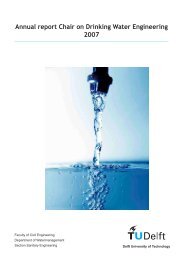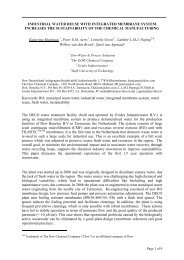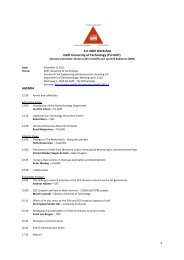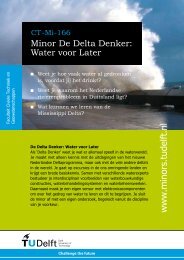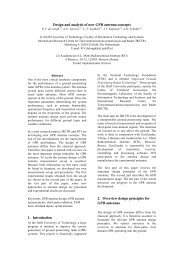Annual report Chair on Drinking Water Engineering 2008 - TU Delft
Annual report Chair on Drinking Water Engineering 2008 - TU Delft
Annual report Chair on Drinking Water Engineering 2008 - TU Delft
You also want an ePaper? Increase the reach of your titles
YUMPU automatically turns print PDFs into web optimized ePapers that Google loves.
Modeling of biological activated carb<strong>on</strong> filtrati<strong>on</strong><br />
Research objectives<br />
The research objective is to develop a quantitative simulati<strong>on</strong> model for biological activated (BAC) filtrati<strong>on</strong> in<br />
drinking water treatment. The model includes adsorpti<strong>on</strong> and biodegradati<strong>on</strong> processes and should be able to<br />
predict the removal of natural organic matter (NOM) and pesticides.<br />
Project outline<br />
Introducti<strong>on</strong><br />
Pre-oxidati<strong>on</strong> prior to granular activated carb<strong>on</strong> (GAC) filtrati<strong>on</strong> enhances biological activity, resulting in NOM<br />
removal. Oxidati<strong>on</strong> also reduces adsorbability of NOM. Both phenomena result in lower solid-phase c<strong>on</strong>centrati<strong>on</strong>s<br />
of NOM <strong>on</strong> activated carb<strong>on</strong>. The reduced solid-phase c<strong>on</strong>centrati<strong>on</strong>s causes less competiti<strong>on</strong> between<br />
pesticides and NOM, resulting in l<strong>on</strong>ger filter run times for pesticides.<br />
Approach<br />
Based <strong>on</strong> literature review a white box simulati<strong>on</strong> model for BAC filtrati<strong>on</strong> was developed. In an other work<br />
package of the project a biomass quantificati<strong>on</strong> method based <strong>on</strong> adeninotriphosphate (ATP) was developed<br />
and the dominant bacteria species in BAC filters were determined and characterized. Laboratory experiments<br />
were performed to determine the effect of oxidati<strong>on</strong> <strong>on</strong> the adsorpti<strong>on</strong> characteristics of the NOM. This provided<br />
data for model calibrati<strong>on</strong>. Pilot plant experiments for both ground and surface water were used for<br />
model validati<strong>on</strong>.<br />
Results<br />
Laboratory experiments showed that due to oxidati<strong>on</strong> and biodegradati<strong>on</strong> the solid-phase c<strong>on</strong>centrati<strong>on</strong>s of<br />
NOM reduce to 50% of the original values. Pesticide spiking experiments in a pilot plant at c<strong>on</strong>centrati<strong>on</strong>s of<br />
2 µg/l showed that BAC filter run times are up to two times l<strong>on</strong>ger than GAC filter run times (see figure 1). In<br />
the pilot plant biomass profiles were determined with the ATP <strong>on</strong> carb<strong>on</strong> method. Surprisingly ATP <strong>on</strong> carb<strong>on</strong><br />
c<strong>on</strong>centrati<strong>on</strong>s peak in spring and not in summer when temperatures are maximal.<br />
atrazine [µg C/l]<br />
2,5<br />
2<br />
1,5<br />
1<br />
TW-BAC1:<br />
0.7 g O3 ·g C<br />
influent<br />
0,5<br />
0<br />
EBCT 5 min<br />
EBCT 10 min<br />
EBCT 20 min<br />
0 100 200 300 400 500 600 700<br />
Time [days]<br />
Figure 1 - Atrazine breakthrough in GAC and BAC at empty bed c<strong>on</strong>tact times of 5 min and 10 min<br />
-1<br />
0-12 g H2O2 ·m-3 44 <str<strong>on</strong>g>Annual</str<strong>on</strong>g> <str<strong>on</strong>g>report</str<strong>on</strong>g> DWE <strong>2008</strong><br />
TW-GAC1:<br />
0 g O 3 ·m -3<br />
0 g H 2 O 2 ·m -3<br />
influent<br />
EBCT 5 min<br />
EBCT 10 min<br />
EBCT 20 min



